#Katsura Hashino
Text
Random tidbits from Hashino's interview in the Persona Club P4 book

At the back of the Persona Club P4 fanbook, there's a 6 page interview with Katsura Hashino about the making of Persona 4. This interview is spoilerific and you have to cut the pages of the book to even read it lol. I have 0 desire to translate the entire thing (I don't trust myself with that, ngl), but here are some fun highlights from it related to Adachi. This interview/book was published in 2009, so before the anime aired, before Golden, before Arena, etc.
The identity of the true culprit - who filled Adachi's role before Adachi?
While developing the story, it originally had Izanami (Hashino very specifically mentions Izanami was planned since the start) and Namatame, and one of the themes was "how the characters get info". From what Hashino says, Namatame's role during this earlier stage in development sounds very similar to what we got in-game. Back then, he was considered the true culprit and he was well-meaning, but he lacked some pretty critical info. After Namatame, there would be the feeling that there was still someone out there, but that someone was Izanami, not Adachi.
The staff felt the plot was lacking, so they wanted to add in a stepping stone between Namatame and Izanami as an extra plot twist - a true, true culprit. And the first character who they considered for the role of the true culprit was................... not Adachi.
The very first candidate for the true culprit was Yukiko. Yup. This came from a half-serious, half-joking convo between Hashino and Soejima. Their reasoning for picking Yukiko was because in the Kindaichi Case Files, whenever there's a murder in the sticks, it's always the lady who runs the ryokan who's the culprit.
The next person who they considered was.......... Yosuke. They thought that because of how his character was shown as a decision maker with a good head on his shoulders, maybe he'd have a relatable reason for devising everything? They talked about making him a villain who would still be adored by players regardless. But Hashino was against the idea of having one of friend group as the culprit.
Ultimately, the reason why neither Yukiko nor Yosuke became the culprit was because their motives for murder would be too personal. Hashino thought that if it's murder driven by personal motive, then players won't be as invested. A personal motive would be too much like the "Tuesday Mystery Theater", a Japanese mystery TV show that was - from my understanding - character driven drama.
Hashino went back to the theme of "how the characters get info". At the time, there existed a person in the plot who's function in the game was to give the main cast information from the police's side. This character just so happened to give you info, and seemingly consequence free on their part - after all, what you did with the info after had nothing to do with them. They were careless. And Hashino followed this train of thought, thinking that kind of carelessness went well with antagonism.
Originally, Adachi was the aforementioned character. He was not the culprit, and he gave the characters info about the police's investigation. Following Hashino's train of thought, then the person who was giving away information would become this new culprit between Namatame and Izanami.
But there was an issue - if he was giving the main cast info about the investigation, then he would stand out among the adult cast, and him standing out might spoil that he's the true culprit. Thus, Hashino changed directions during development and started to create Adachi's character.
(See bottom of this post for a footnote about Adachi's old character design and some ramblings about his old role.)
The Thousand Curses and the Myriad Truths
Per Hashino, Persona 4 is about media literacy (no seriously it says media literacy in katakana wasei-eigo even). Izanami's Thousand Curses represents the lies of the media that humans believe in. The protagonist's Myriad Truths represents how, in this sea of misinformation and lies, you can only trust and believe in the words of those who are close to you.
(I suppose now is a good time to mention that the Japanese name for Myriad Truths is "Tens of Thousands of [Mantras / True Words]". A mantra is a phrase/word you repeat over and over, so it seems the Myriad Truths is a visualization of the protagonist unleashing all of the truths from his social links and bonds. All 10,000+ of them.)
Adachi's Given Name
Adachi's given name was not always Tohru. At first, it was Tamotsu, which is written 保. Hashino changed it to Tohru because the character for Tamotsu 保 could also be read Yasu when used as a name, and at the time, the staff was trying not to spoil who the culprit was.
Why would Tamotsu / Yasu spoil the game, though? Because "Yasu did it!" is an old ancient ur-spoiler meme thing from the 1983 adventure game the Portopia Serial Murders. Think of like... "soylent green is people", "Darth Vader is Luke's father", "Sephiroth kills Aerith", etc. Not only that, but the main character of Portopia is a detective, and Yasu is your buddy cop sidekick.
Hashino was already aware of the Yasu comparisons because one of the staff who read the script reacted by going, "So Yasu did it, huh?" But Hashino thought that Portopia was so damn old that gamers wouldn't know about it. Only turbo nerds working at Atlus know Portopia, right?
Wrong lmao turns out a shit ton of people knew about the Portopia spoiler. After character art of Adachi was released in a magazine promo for Persona 4, people reacted with, "Yasu did it", so Hashino very quickly changed Adachi's given name.
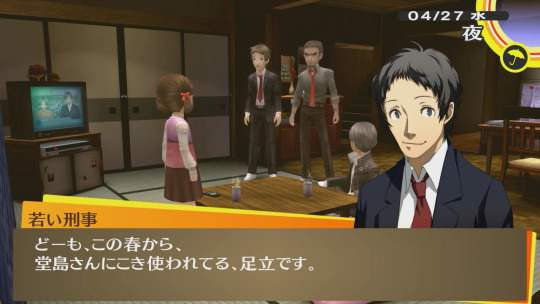
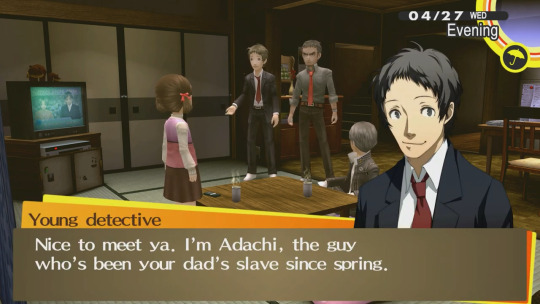
They had already recorded the audio for the game at this point, which included a line of Adachi saying, "I'm Tamotsu Adachi" when he introduces himself. Hashino had the audio team cut out him saying "Tamotsu", and this is why Adachi says, "I'm Adachi" and not "I'm Tohru Adachi" in April.
I'm sure there's an alternate universe where his name stayed Tamotsu and in that universe I am instead blogging about how you can read it as "Yasu" while explaining the Portopia Serial Murders. :')
Footnote Commentary

If you're familiar with the Persona 4 Design Works, Adachi's page mentions that originally during development, he wasn't the culprit but rather a misdirect. After his role in the story was revised to be the true culprit, Adachi's design was also revamped to be the design we know of today. But this red haired design was his original design back when he was apparently just a leaky faucet. I suppose since we know his name used to be Tamotsu, we can call this version of him "Tamotsu" lol.
Hashino doesn't really go into what he meant by "create Adachi's character", but I'm assuming since the Adachi character already existed in the plot, he meant like... "re-create" the character to fit this new role as the true culprit with this consideration about how he'd come off in the plot.

Hearing that the character originally gave you legit info about the police investigation is interesting, cause in the Design Works, opposite this page of Adachi's old design, Soejima also mentions that Adachi was originally a red herring. I can see how those go hand in hand - a guy feeding you accurate info? How would that not be suspicious?
I also get the impression that Hashino is indirectly saying that the Adachi we got in-game also feeds you bullshit, as to make him seem *less* suspicious, if him giving you legit info would make him more suspicious. Which, well, considering the first thing he says is, "Yukiko did it!" ...Hmm yeah okay lol.
I was pretty amused to see that Yukiko and Yosuke were names being tossed around to be the true culprit. Wild to see that the ancient internet rumors are actually true. Notably, Dojima is still not true. Very funny to read that the real origin was some partially nonsense convo between Soejima and Hashino where they're like, "Hey, so, about the Kindaichi Case Files."

The real moral of the story here is that Adachi is truly no one's first choice. Even his role as the true culprit was originally just a confused Namatame.
#persona 4#tohru adachi#yukiko amagi#yosuke hanamura#izanami persona#taro namatame#interview#katsura hashino#shigenori soejima#日本語ヘタです#im going to be laughing about the yasu thing for a good year#adachi going “yukiko did it” when she was the first pick for the true culprit is really fucking funny#persona club p4
71 notes
·
View notes
Text
I thought it was a nice touch in Persona 5 Royal that the scene where the player is given the option to choose to have Joker enter a romantic relationship with Makoto takes place in the Lala Escargot’s Okama bar “Crossroads!”


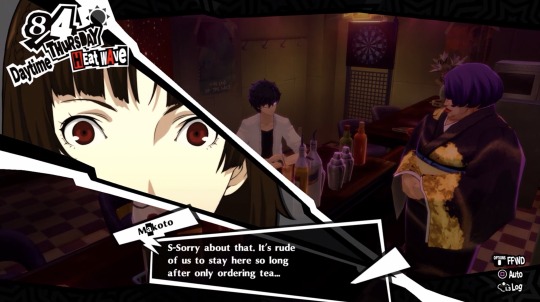



Although Atlus as a company unfortunately has a track record of including homophobic & transphobic stereotypes in several of their games, even in vanilla P5 which has that AWFUL 3-minute-long scene where two predatory gay men sexually harass Ryuji and it is played for “comedy” (although thankfully, the Royal edition at least tried to censor & rewrite the scene for the American localization, wherein the two men were now instead overly enthusiastic drag queens who mistaken Ryuji for one as well and want to give him a make-over after they saw him exit the Crossroads bar…), I honestly thought that the bartender Lala Escargot was a more positive example of a genderqueer character in the game. While the game never specifies whether Lala is actually a trans-woman or just a drag queen, she’s at least never treated like a joke since the all the other characters respect her pronouns, she acts as a responsible voice of reason, and she repeatedly defends Joker during Ohya’s confidant line whenever the drunken journalist tries to offer him alcohol (Lala doesn’t put up with Ohya’s bullcrap). And I know that I’m alone in that opinion that Lala is one of Atlus’ more positive or less problematic examples of LGBTQ+ representation, since I’ve seen other players compliment her character as well!


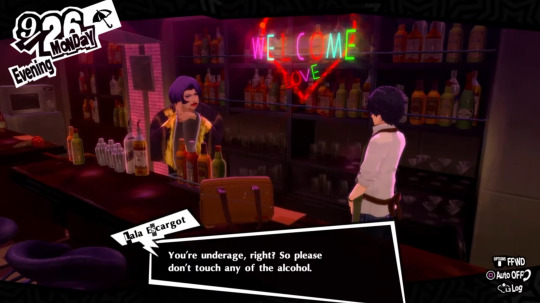


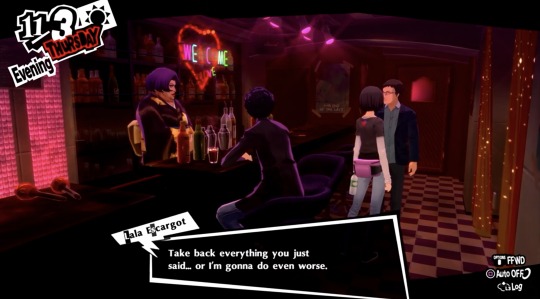
Still, even though I thought Lala was a solid step in the right direction (even if it's still imperfect) despite P5’s other problems with queer rep, I do hope that Atlus tries to do better going forward in future games, especially considering that the Persona franchise is no longer being directed by Katsura Hashiro since most of the widely criticized queerphobic content occurred under his leadership. Heck, even the Royal re-release for P5 (which rewrote the aforementioned homophobic scenes to make them less problematic) had a different director, Daiki Ito, who thankfully gave us more queer-coded bonding moments between Joker & Akechi (I totally ship them together as boyfriends, similar to how I also ship Joker with Makoto).

#persona#persona 5 royal#persona 5#p5 royal#lala escargot#joker p5#ren amamiya#makoto niijima#ichiko ohya#goro akechi#genderqueer#drag queen#lgbt representation#queer coding#cw: homophobia mention#cw: transphobia mention#Katsura hashino#daiki ito#atlus games#video games
7 notes
·
View notes
Text
Persona 3 P3 ペルソナ3 Director: Katsura Hashino

View On WordPress
0 notes
Text
i know this is an incredibly old interview but hashino saying he thinks persona 4’s story wouldn’t have worked with a female protagonist because “it seemed more natural for a male protagonist to come from the big city to the country” is just. incredible
#adri.txt#katsura ‘i’m gonna make a game that ostensibly criticizes misogyny while actually being really misogynist’ hashino
9 notes
·
View notes
Note
Hello! Apologies for sending an ask out of the blue but considering your familiarity with localisation differences in persona 4/golden, I was wondering if anything comes to your mind regarding this aspect and how the game depicts queerness and queer themes? Thank you!
Heya! Don't worry, I was thinking people would probably ask stuff like this. After all, I already replied to somebody's tags asking this same thing previously, but I know not many people saw that, so let me use the chance to go into more detail:
Unfortunately, Persona 4's treatment of queer themes is not a result of the translation. The only things that were down to translation choices were small things, such as which pronouns are used in which situation (because Japanese does not at all have the same concept of third person pronouns as English, and the way first person classifiers that mean "I" work is very complex and a lot more vibes-based than actually tied to gender.)
But for the most part, everything is pretty much the same. Kanji's reaction to Chie mumbling about something being "off" about how he interacted with Naoto that first time, the tent scene, Yosuke's extreme insecurity in his own sexuality in addition to everyone else's... I think maybe the only thing that's a biiit better in Japanese is that Teddie is kiiinda genderfluid in Japanese, with the artbook outright stating that he doesn't necessarily consider himself "male" when he's in his bear form, unless it's necessary for a joke.
A lot of this can be traced to the really odd relationship the game's director, Katsura Hashino, has to queer themes. In interviews about Catherine Fullbody (a game which infamously has a rather weirdly handled gay romance route which, however, is notably also the only romance route in the game that cannot possibly result in a bad ending), he talks about how he's always admired queer people for being "strong" and wanted to write queer stories, but couldn't really do it until Fullbody because Atlus higher ups were afraid of backlash from the fans.
Traces of this are actually seen in Persona 4 Vanilla's data, where remnants of a surprisingly well done romance route for YOSUKE, of all people, are still present. That route made it far enough into development to have voiced lines in both, English and Japanese. However, it was dummied out in the final game and its script content was removed. Yosuke STILL has the "girlfriend flag" in the code that all the female romance options also have, but in the finished game it only checks whether you can hug him during his social link or not. Everything else was dummied out. You can still find the voice files on the cutting room floor if you want:

And yes, the "I like you" line is unambiguously romantic in Japanese. His wording is very hard to misinterpret.
However, in the finished game and the rest of the franchise Yosuke's bisexuality was reduced to an in-joke of the developers. It's most poignant in Persona Q (the first one), where if you get the "marriage" scene with Yosuke in the second dungeon, his reactions differ WILDLY depending on which Protagonist you are playing as, far more than other male characters. With Makoto Yuki he acts nonchallant and deadpan about it. With Yu Narukami he acts like a blushy Tsundere and panics constantly. So, yeah.
Okay, so, if the director had interest in writing queer stories since before Persona 4, why is Persona 4 the way it is then?
Well, because - and there's no way around it - he sucks at it.
Katsura Hashino has to be one of the clumsiest "gay activists" I've ever seen in my whole darn life. He finds queer people "cool", but seemingly never had any queer writers or sensitivity readers on his teams and it's caused enormous blunders in how these themes have been handled. For example, when after Persona 3 it was pointed out to him that the writing of the female characters in interaction with the male characters was bad, he immediately hired more female writers and gave them free reign for how to handle the female characters from then on out. But apparently the same thing never happened with his mishandling of queer themes. He wants Catherine's Erica and Rin to be empowering figures for trans women and gay men, but makes a lot of blunders in how he has other characters interact with them to the point it buries his good intentions. Erica's boyfriend having gay panic upon realizing she's trans is treated as "funny and cute", even by Erica herself. Rin technically being a monogender alien really undermines his story of becoming more secure in his sexuality. It goes on and on like that.
The intention with Naoto's story was to point out the extreme sexism in Japanese society and how it forces female nerds to find alternate modes of self-expression, but the clumsy choice of including surgery themes in Naoto's dungeon completely buried that for especially western queer audiences. Most people don't even remember Naoto's dungeon was outright modeled after a Kamen Rider villain hideout. They completely shot themselves in the foot with this one. Additionally, the way Naoto is handled AFTER the dungeon makes her (I'm using that pronoun because she calls herself a "woman" in Japanese in the game) seem more like someone who's on the verge of discovering they are X-gender (the japanese word for "nonbinary") than a repressed girl. Like, right down to how she has Rise help her experiment with clothes in the canonical drama CDs only to realize she really is uncomfortable with skirts and go for an androgynous but less restrictive look going forward. The way she dresses in the Golden epilogue and P4D is pretty X-gender core if you ask me. If they had leaned into that they could have genuinely have had something AMAZING, while also presenting the themes of sexism they wanted to explore, but the lack of queer sensitivity readers kind of ruined it.
Same for Kanji. The way they write him makes it seem like he's bisexual or pansexual, rather than straight, but they kinda shove that part of him aside after his dungeon is done, leaving his actual orientation up in the air and wasting a really good chance for representation. NOW, given what happened to Yosuke's social link, it's quite possible the original intent WAS to explore this more and it got cut, but as it stands, we'll never know. The huge problem of the internalized toxic stereotypes his Shadow presented never being reflected on and put into their right context in the rest of the game, when his social link could've given a great opportunity for that is also a huge shame.
All of this happened because of Atlus being unwilling to let their writers go all out with queer themes in fears of alienating a cishet audience AND because Hashino never sat his writing team down with any actual queer writers to sort this shit out and learn how to get across what the team was ACTUALLY trying to say. Now, given, Persona 4 was far from the only Japanese media property with that exact issue at the time, but it hurts especially much in its case because of the game's themes of exploring the truth to its logical conclusion, as well as psychology. These are issues that a remake REALLY would do well to address and correct. I feel like they actually will HAVE to do that, because sensitivity readers have become the NORM in handling these themes now in Japanese media, rather than the exception. You can thank trail blazing mainstream works like Zombie Land Saga for that.
All in all, Persona 4's handling of queer themes is an exercise in frustration that I hope is corrected soon.
74 notes
·
View notes
Text
youtube
Metaphor: ReFantazio — The Royal Tournament
youtube
Japanese version
youtube
Official website footage
Metaphor: ReFantazio will launch for PlayStation 5, Xbox Series X|S, PlayStation 4, and PC (Microsoft Store, Steam) in Fall 2024.

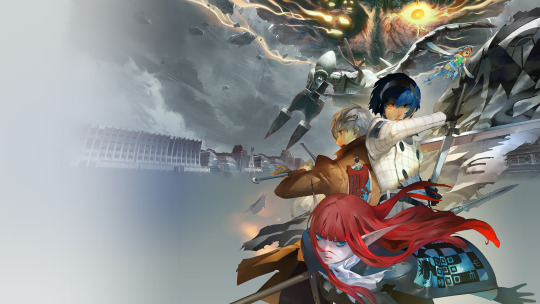
Key visual
Latest details
■ Story
This is a story of how people must find unity to elect a new king.
Our story takes place in The United Kingdom of Euchronia, where the assassination of the king brings chaos and unrest to the land.
Then, one fateful day, a magic known only to the king called the Royal Magic is invoked, and the world becomes embroiled in a royal tournament for the throne.
In the midst of this, the protagonist, together with his partner, the fairy Galica, must find a way to break the curse that has been placed on the prince that the kingdom believes to be dead. To do so, they depart on a journey across the vast land.
They will discover that in order to achieve their goal, they must participate in the tournament for the throne, and this great task shall require them to ally with many friends and followers of the various tribes inhabiting the world.
■ Characters
Protagonist (voiced by Natsuki Hanae)

Together with the fairy, Galica, he embarks on a journey to lift the deadly curse placed on his childhood friend, the prince of Euchronia.
He is a boy of the elda tribe, branded as a “tainted” people by the state religion who believe they have inherited dangerous and heretical magic. Being so rare among the populous, they are detested and discriminated against throughout the kingdom.
Gallica (voiced by Sumire Morohoshi)
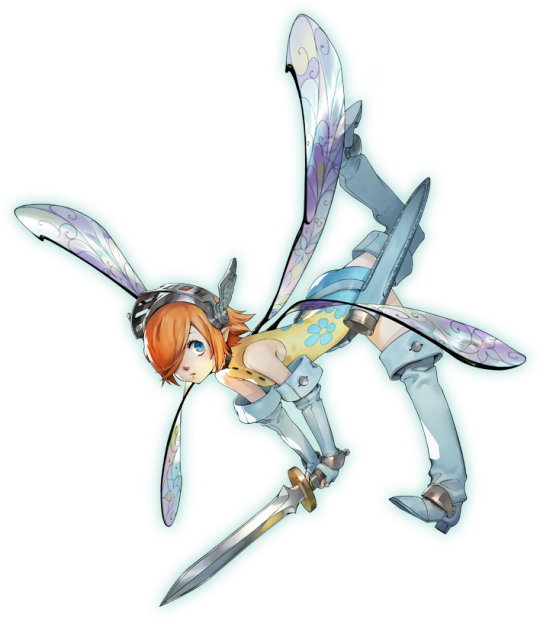
Not only a traveling companion, Gallica is the guide who helps the protagonist carry out his mission to save the prince. Although she is too small to participate in battles, her knowledge of magic and ability to sense magla is superior to the protagonist due to her fairy nature. She doesn’t mince words, but she is a reassuring ally on his journey.
Strohl (voiced by Kensho Ono)

He is a young man of the clemar tribe who meets the protagonist in the recruitment centre for the State Army. A smart young man with a strong sense of justice, he hails from a noble family. And yet, it seems his circumstances are complicated, as it is rare for a noble to enlist in the army alongside commoners.
Hulkenberg (voiced by Saori Hayami)
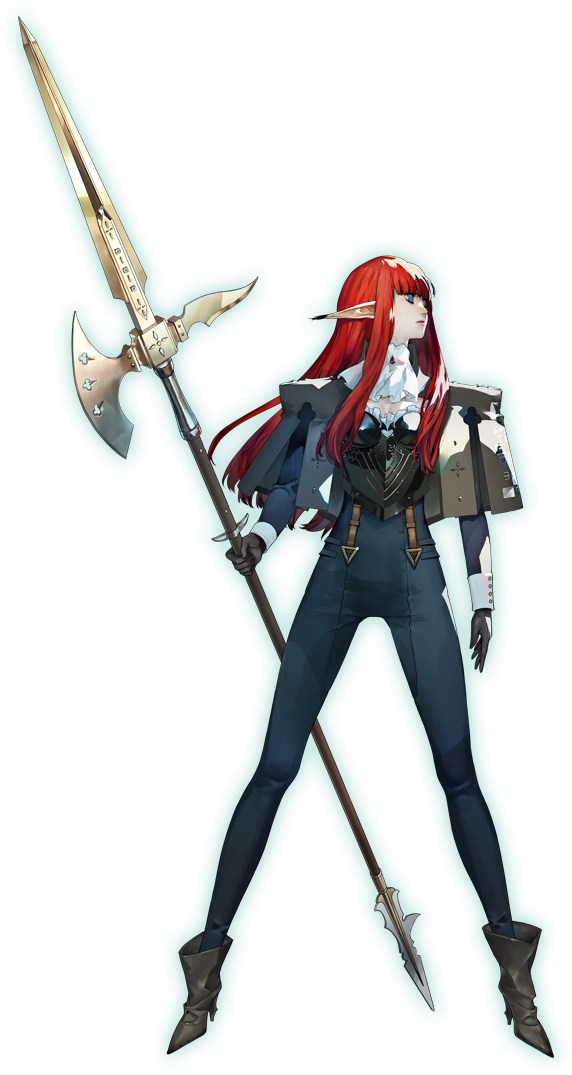
A knight of the roussainte tribe and former member of the royal family’s Kingsguard who served by the prince’s side. Despite her young age, she excelled in the use of various weaponry, and was assigned to the personal guard of the prince. But when the prince was attacked, she failed to protect him and set out to wander, carrying the stigma of this failure in her heart.
Heismay (voiced by Akio Ootsuka)

A former knight of the eugief tribe. He has acute perception compared to most others, due in part to the eugief trait of being sensitive to sound.
With an appearance that differs greatly from other tribes, it’s not uncommon for eugiefs to be discriminated against—and it seems Heismay is no exception, his past his own burden to bear.
■ Followers
Meet and bond with your followers.
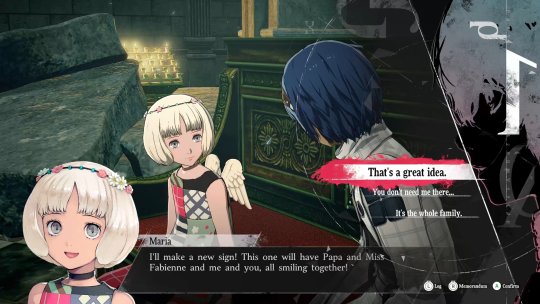


■ Game Mechanics
Unique battles that combine action and turn-based commands. Party customization offering a high degree of freedom and strategy. An evolution of the realistic day-by-day journey of the Persona series.
youtube
■ Staff
Director – Katsura Hashino (Shin Megami Tensei III: Nocturne, Persona 3, Persona 4, Persona 5)
Character Designer – Shigenori Soejima (Persona 3, Persona 4, Persona 5)
Composer – Shoji Meguro (Shin Megami Tensei III: Nocturne, Persona 3, Persona 4, Persona 5)
Concept Artist – Koda Kazuma (Notable Work: NieR:Automata)
Mechanical Designer – Ikuto Yamashita (Notable Work: Neon Genesis Evangelion)
■ Art and Sound
Journey through a vast and magnificent fantasy world. Explore the game alongside an intuitive and beautiful user interface that elevates the experience. Lend your ear to masterfully crafted music utilizing captivating unique chants.
youtube


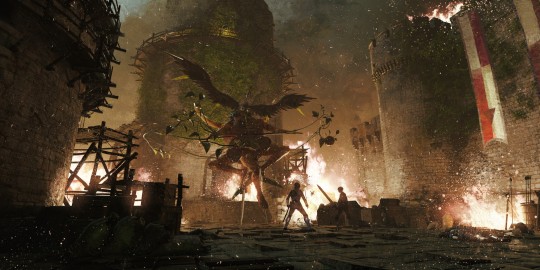
■ New Screenshots
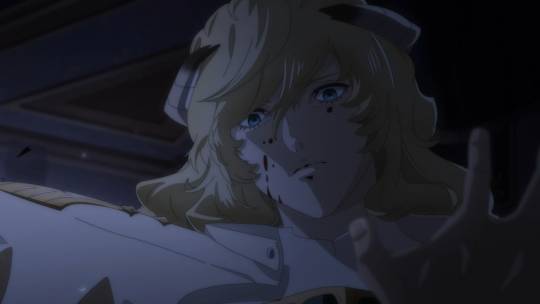




#Metaphor ReFantazio#Metaphor#ReFantazio#PROJECT Re FANTASY#Studio Zero#Atlus#video game#PS5#Xbox Series#Xbox Series X#Xbox Series S#PS4#PC#Steam#Microsoft Store#The Game Awards#TGA 2023#long post#Youtube
43 notes
·
View notes
Text
Okay, I'm a bit late to the game, but I have some THOUGHTS after watching this weeks stream from Atlus about their new game, Metaphor: ReFantazio!
If you don't know yet, Atlus is releasing a new IP created by three of the main members of the team who helped develop Persona 3, Persona 4, and Persona 5! This of course includes:
Katsura Hoshino, who was the director for the past main Persona games, as well as SMT 3: Nocturne and Digital Devil Saga, until he moved on to create Metaphor with Atlus's new division, Studio Zero.
Shoji Meguro, the composer for a LOT of Persona's most well-known music who has composed a new, equally stylistic soundtrack for the new game!
And Shigenori Soejima, the main character artist and designer for Persona who has created similarly distinct and unique character designs for the vast cast in Metaphor!
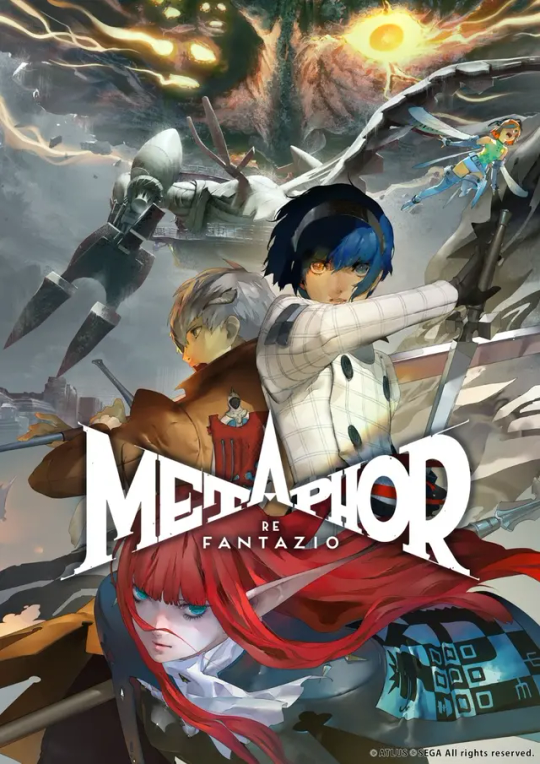
The game is set in the United Kingdom of Euchronia, a pseudo-fantasy world that is described as a "mirror" to our world, where humans are feared by the many tribes that dot the land. After the sudden assassination of the King, we the protagonist, among many other individuals from the tribes around the kingdom, are chosen to join in a impromptu Royal Tournament to determine who shall become the throne's successor!
Similarly to Persona, the game has a focus on time and how your choices affect the world around you. From what we saw in the stream, our team of characters have a limited time to complete the various quest bestowed upon us, some side quests, some bounties, and others of course being story important quests. Alongside that, our biggest goal in-game is to try and gain the support of the people and gain allies in a Social Link-like system with specific NPCS of specific tribes, villages, and cities!
I'm a bit excited to see how they change up this system from Persona's social links, and what ways they may potentially affect our gameplay! Will they provide us certain special abilities like Persona 5's Confidants? Or will we be able to get some special teammates we might normally not get in the story?
Alongside that, the game also has a lot of other features commonly shared with both Persona and SMT, including the turn-based battle system and a lot of familiar physical, magical, and stat affecting abilities! Though the magic does go by different names this time, such as "garu" being referred to as "cyclo" instead! But hey, we still have tarukaja and matarukaja, so who knows what else may have reutrned or changed?
Unlike Persona though, the game has quite a few distinct differences too, notably the travel system and specific changes to the battle system. In Metaphor: ReFantazio, travel is a very important aspect of the game as our party moves across the kingdom, going from town to town to gain the support of the locale. We enter dungeons that are found in semi-open exploration locations and fight through them
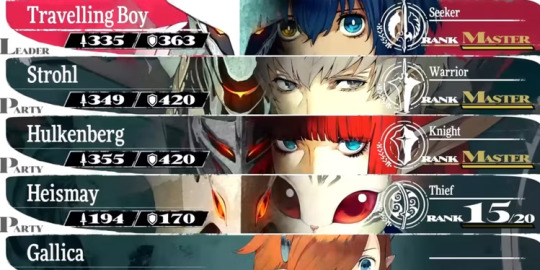
As for the fighting system, there are two main differences from both SMT and Persona that folks may notice; The ability to fight outside of turn-based battle, and the Archetypes System.
Similarly to games like Final Fantasy 15, Persona 5 Strikers, and the Dynasty Warriors series, Atlus has implemented an action role-playing battle system that allows you to either take out weaker enemies quickly in the overworld without engaging in turn-based combat, or getting a a few hits in on a stronger before switching over to turn-based fighting! Hashino noted that the reason why they did this was to make the gameplay flow a bit more enjoyable by eliminating constant turn-based battles with weaker enemies.
Some folks don't seem to quite like it, but personally I'm a bit indifferent. On one hand, constant turn-based combat can get a bit boring and resource wasting when fighting enemies that are weaker than you, a problem that I have faced a bit so far during my current playthrough of Persona 3 Reload. But on the other hand, there is always something enjoyable about being able to defeat enemies with ease and getting a few extra experience points, so we'll just have to see how it feels!
Then comes the most distinct part of Metaphor's battle system so far; The Archetypes. Our team of characters have the ability to awaken to powerful, magical weapon forms known as Archetypes, which are described as "individuals who embody the traits of typical fantasy classes like a knight or warrior, who can then transform into their Archetype once they awaken to this knowledge."
Sounds a little similar to Persona, no? Well, a lot of people, including news companies like Polygon, Kotaku, Game Rant, and more have compared the Archetype system to the Persona system, since it allows you to utilize different forms with different abilities and statuses. However in my opinion, I believe that the Archetype system is more akin to another system we've seen in a game from Hashino....
The demon transformation system in Digital Devil Saga 1-2.
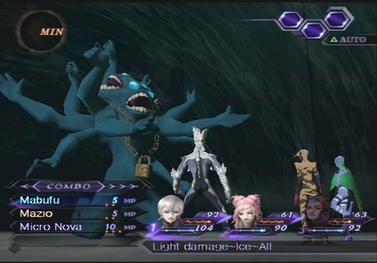
Unlike the system in Persona, which allowed your protagonist to utilize multiple Personas alongside your teammates singular Personas, Digital Devil Saga's demon system had a different focus. You and your teammates have the ability to switch between human and demon forms, with each specific characters demon forms having a variety of special stats and magic specific to them.
However, there is one distinct aspect to this that is similar to Archetypes system: The ability to gain specific magic and change your stats via a skill tree. Both the demons in Digital Devil Saga and the Archetypes are able to change aspects of their builds in unique ways, providing them magic that they otherwise wouldn't have had before, or specific skill boosts that change them entirely. You could change an ice magic focused demon into fire resistant physical figther, and vice versa!
And ultimately, unlike both Persona and Digital Devil Saga, any character can equip any Archetype, allowing for versatility when it comes to the players fighting style! A good example that Hashino gave during the presentation was equipping all the characters with the Brawler archetype, boosting all of the characters defense and physical strength, and providing them all physical based skills instead of magic So, while there are quite a few similarities to Persona, there are also a lot of similarities with past SMT projects directed by Hashino too!
Overall though, I can safely say that I am VERY excited to see whats in store for Metaphor: ReFantazio since I'm an absolute sucker for the Persona games, but also new RPGs in general! I'm looking forward to seeing what other information comes out while waiting for both the games release and any future news for Persona 6, and hope that anyone else reading this might be too!
16 notes
·
View notes
Text
people will argue in circles forever about which modern persona game is the best (3 >>> 5 >>>>> 4. btw) but i think, having obsessed over the series for most of my early teens, my main takeaway is that we shouldn't let katsura hashino make games. like why hasn't anyone stopped him yet
12 notes
·
View notes
Text
8 notes
·
View notes
Text

Source: Dreamcast Magazine November (17/26) 1999 Volume 36
Katsura Hashino (橋野 桂)
Kei Sagami (相模 桂)
"桂" can be read as both Katsura and Kei
31 notes
·
View notes
Text
Translation: Katsura Hashino's 2008 Persona 4 Developer Interview (Parts 1/3/4)
I paraphrased and summarized parts of this interview before, but now, here is an actual full text translation... This was translated by Alex Highsmith of Shmuplations, a professional who has translated a ton of video game developer interviews before. I asked him to do these 3 specific parts as I believe they are the juiciest parts of this interview and probably the most interesting to people who are fans of Persona. Full text below the read me cause of how long it is. (゚Д゚*)ノ
You do not have permission to post anything from this interview on the god awful Fandom wiki.
--------
[[PART 1]]
--I understand the title "director" implies a range of different jobs, depending on the project in question, but would you mind explaining in detail what your role in Persona 4 entailed?
Hashino: Mainly, designing the systems and crafting the rules for the game. I also worked on the story outline and themes. I left the details up to the staff who were specifically in charge of the scenario and system design, but I would also make revisions and changes to the stuff they brought to me.
--That's actually a great transition for my next question: what is/are the theme(s) of Persona 4?
Hashino: The theme, um… it's a small-town murder mystery. (laughs) First and foremost, I wanted to make an RPG that would revolve around a murder mystery. After Persona 3, we worked on P3 FES, and we were developing P4 in tandem. I spent some time thinking about what the players who enjoyed P3 would find interesting in the next game--what would they like to see. From there, our ideas eventually took the shape you see today, of exploring a string of murders in a small country town.
--So, just to re-cap then: with P3 in mind, you decided to set this game in a completely different small town, then for the plot, you arrived at the idea of a serial murderer…? Is that about right?
Hashino: Well, not exactly--the "small country town" and "murders" ideas basically came together as a set in my mind. It's kind of a Kosuke Kindaichi vibe… I've always loved those kind of mysteries, where a person from the "big city" visits a small town, and during his stay he solves a mystery of some type.
--That reminds me of Kindaichi's works like Inugamike no ichizoku (The Inugami Clan) and Yatsuhakamura (The Village of Eight Graves). Do you like mystery novels, then?
Hashino: I'm not an expert or anything, but it's a genre I've enjoyed since I was younger.
--What are some of your favorite works?
Hashino: For older stuff, I like Arthur Conan Doyle and Agatha Christie. Also, he's a sci-fi author, but I also enjoy writers like Isaac Asimov. I love those classic older works, and when I was a kid that was all I read. You know there were those kids in elementary school, right? The ones for some reason would write all their book reports on mystery novels?
--Ah, yeah! There were some kids like that at my school too. (laughs) So then, why did you decide to add mystery elements to Persona 4?
Hashino: I think it should be obvious to players what's interesting about your game, and what kind of story it is, before they buy it. This is something I reflected on and realized after Persona 3, but for the earlier games, it was hard to know what they were about until you played them. So this time, the premise is simple and upfront: there is a murder incident in a small town, and the adults are oblivious to the truth of the situation. The protagonists then proceed to investigate--sort of like a Junior Detective League--and attempt to solve the mystery.
--You mentioned the earlier games and reflecting on them… am I right to assume you weren't only looking at P3, but were thinking about the whole flow of the series, all the way back to P1?
Hashino: No, in terms of being inspired to make the content of the game more obvious, I was talking about P3. The truth is, P2 and P2: Eternal Punishment were so long ago, I wasn't really thinking that far back. Plus the fans themselves consider P2: Eternal Punishment to have wrapped everything up. However, when the very first Persona came out, the developers then (my senior colleagues) were trying to make a new style of Megaten game, something that would appeal to more casual players. So for me personally, there was a sense of going back to the roots in wanting to do the same thing with P4.
--Would that include the basic question of "what are Personas…?"
Hashino: Yeah. We tried to depict these characters' struggle in a head-on, direct way, while at the same time returning to the fundamentals of the Persona series. That is, rather than thinking in terms of sequels and multi-part stories, we wanted to go back and once again ask ourselves, "OK, so what role were the personas really meant to occupy in this world…?" And what approach would be best to attract a new generation of users and show them the appeal of Atlus' RPGs…? We talked about what makes a Persona game a Persona game… were there necessary criteria? For example, with the progenitor of Persona, the Megami Tensei series, you've got the light side and the dark side, that contrast of exterior and interior (omote and ura)--if those are the foundations of Megaten, then what are Persona's…? Those were our questions as we began the development of P4, and to tell the truth, I was somewhat uneasy about the answers we would reach. When I look back at P3 now, it ended up being a big success, and ultimately that's the most important thing for any game.
--Did that anxiety stick with you until the reviews finally came in?
Hashino: I mean, there were people at Atlus saying stuff like, "Maybe we shouldn't have called it a Persona game…" and "This isn't Persona." (laughs) But the opinion of the players is the most important thing, so now I can say that I'm very satisfied.
--So do you know now precisely what makes something a Persona game?
Hashino: Hmm, well… one example, I guess, would be the "angsty" feeling of the games. When you're young, much of your life is managed for you by adults, but eventually everyone has to break out of that protective shell--and it's a bit like being on a train where the rails suddenly disappear, isn't it? Sooner or later, that time comes for everyone, but that de-railing provokes a keen sense of angst in many young people. Yet it's almost like we don't want to forget those times… there's a nostalgia for it, you could say. When you become an adult and are stressed out by your job, it's very difficult to find the time to re-discover yourself. I think it'd be cool if Persona can provide people a chance to re-experience that in game form, to go back to the beginning and reflect on it all once more. Of course, I don't think this is unique to Persona--there's a lot of works of art in the world that have a similar appeal.
[[PART III]]
--Going back a bit, I wanted to ask some more specific questions about the development process. What were some of the challenges you faced in creating a mystery?
Hashino: I'd say one big challenge was interweaving the real-world elements of the murders with this fantastic psychological world where you're battling with personas. I mean--OK, there's these murders, but then if all of a sudden a Shadow pops up out of nowhere, it would be like… "forget these murders, wtf is that!!" (laughs) Also, in P3 the dungeon fights were basically just for training, and in the beginning they don't have much connection to the story. We wanted to intertwine those more with the story, so for P4 we first came up with the idea of someone getting kidnapped, taken to this mysterious other world, and you have to go rescue them… and that led to us coming up with the serial kidnapping-murder part of the story.
--It sounds like rather than having a whole mystery story figured out from the get-go, you rather focused on how to artfully interweave the gameplay systems and main story.
Hashino: I often start from the end, so to speak, like coming up first with a catchphrase and working backwards from there. For this game, too, rather than working out the details of the story, I had more general situations in mind: a town is enveloped in fog and a person disappears -> the main character goes to rescue that person. Just that brief outline sounds exciting, right?
--That being the case, at what point did you come up with the character of the villain Adachi?
Hashino: Actually, this goes back to the discussions we had at the very beginning of the development when we were creating the plot, but one of the themes we hit upon was "how do we get our information." So initially, we wrote the true final villain as someone who mistakenly thought they were doing the right thing.
--Are you talking about Namatame?
Hashino: Yeah. And there was something manipulating him behind-the-scenes, and Adachi was not the villain then. However, as the development went on, we felt the story development was lacking in something, and it needed one more twist with regard to who the true culprit was. The first candidate for that role was Yukiko, actually. (laughs)
--What!!
Hashino: Yeah, I mean, when you think about "murders in a small town" stories like this, a Kindaichi story would have the killer be someone like the ryokan proprietress. (laughs)
--Oh yeah… I know what you mean.
Hashino: It was something I talked about Soejima with, only half-joking of course. The idea of Yosuke the villain also came up. He was a character with solid reasoning abilities and good judgement; it would be believable to players, we thought, that he could have plotted everything himself. We also discussed making the culprit a "likable villain". But we were hesitant about making one of your party members the killer.
--Being betrayed by a close friend like that would be quite painful indeed.
Hashino: But the biggest reason we thought Yukiko and Yosuke wouldn't work, was that we thought players would find it boring if we gave the killer a merely personal motivation for his crimes. That kind of simplistic motive belongs in the realm of Tuesday afternoon TV crime dramas. So we went back and re-examined our themes about information: and this links up with the notion of irresponsibility on the part of the person disseminating the info, but when you think about it, doesn't the responsibility for what happens with that information ultimately lie with the recipient? It's hard to explain, but yeah… we felt the connection between ill-intent and that kind of irresponsibility fit the game the best.
--And that's where Adachi comes in.
Hashino: Initially, Adachi was created as a character whose role is to facilitate the exchange of information between the protagonists and the police investigation. But he seemed a little out-of-place there amongst the other adult detectives, and personally, I started to worry that he would stand out to players as odd and it would be too obvious that he was the killer. So we switched gears midway through the development and took his character in a different direction.
[[Note: I spoke with Shmuplations about this particular part and he understands why this sounds confusing: Does Hashino's "initially" mean "Adachi's character existed before we needed a new culprit" or "we then proceeded to make the character of Adachi to be the new culprit"? While he believes the former is more likely, Hashino does not specify this within interview itself.
I believe this can be read in combination with what Soejima said about Adachi in the Design Works where he mentions Adachi used to be a red herring and then was re-designed after he became the culprit. This is further supported by the 2009 Gamasutra interview where Atlus talks about a villain character changing in development but their design being done before the change and the character's design not looking villain-like.]]
--That "something" manipulating Adachi was, of course, Izanami… was that also something that was revised midway through?
Hashino: Actually, Izanami was there from the very beginning. Even before we had the themes figured out for P4, in the previous games we'd used a lot of Greek gods, so we talked about how this time we wanted to focus on Japanese mythology. And so, around the time that we decided on the theme of uncertainty surrounding the truth and the rumors you're hearing in this small town, I thought these native gods and goddesses would be a force resisting that kind of social anxiety.
--I see. And the story of Izanami and Izanagi is one of the most well-known in Japanese mythology.
Hashino: As we worked out the plot, I took that story of Izanagi descending into the underworld (Yomi) and gave it my own expanded interpretation. In the myth, it is Izanagi's inability to accept Izanami's death that, ironically, nearly gets him killed by her: but I added my own interpretation, that the news and rumors we hear from all these sources == death (that is, it's an invitation for you to cease thinking).
--That's an unusual reading.
Hashino: At the time I thought to myself, "Nice, now this sounds like an idea that would be in a Persona game." (laughs) Izanami sees that humanity has stopped thinking critically for themselves and has surrendered to whatever they hear, and she thinks, "These unthinking people might as well be dead, so I will grant their wish. If I'm wrong, prove it to me." Then, when she happens to encounter certain humans that appear interesting to her, she bestows on them the power to change their reality, and that is how it all begins. But the protagonists are far stronger than she had thought, and though she had planned to merely be a spectator, they strike back in a way she hadn't expected. (laughs)
--Does the fact that she is defeated in the last battle mean that she had erred in her judgment?
Izanami: Yes, definitely. The ability Izanami uses in the battle, "Thousand Curses", I imagined it as a metaphor for all the lies the media tells. And likewise the ability the player uses, "Myriad Truths", that represents the trustworthy words of those people closest to you. I hope players get the message I was trying to convey, that no matter how much irresponsible, unverifiable information the world tries to deluge you with, you can always rely on the truths of your trusted friends to see you through.
--Whoa… that's deep!
Hashino: Also, the fact that there is a date and time that the world will end within the game--that day is meant to symbolize imported culture. There's a similar commentary with the native Japanese deities and a resistance to globalism. The way the Inaba shopping district resists the incursion of the Junes department store chain is part of that too.
[[PART IV]]
--I think the story of Persona 4 wraps up very neatly, but was it a smooth process, writing those scenarios?
Hashino: No, it took a lot of time and research to come up with plot twists, red herrings to throw players off the scent, and all the things you would expect to find in a proper mystery. There were a lot of additions and revisions too. As I mentioned above, in particular I wasn't satisfied with the plot development in the first draft, so aside from adding a "true villain" we also made a lot of changes. In the first draft, for example, we weren't originally planning to have Morooka die.
--What?!
Hashino: We had planned to include Mitsuo and the Void Quest, but we wanted to put a big surprise in there that would really betray player's expectations, and sadly for him, Morooka was sacrificed for that.
--It was kind of a shock.
Hashino: Many people told us that, yeah. It surprised us how popular Morooka was.
--He makes a bad impression on you on your first day at school, but there's many moments throughout the game where you realize he actually cares for the students' well-being.
Hashino: Hah, that's so funny, because I had no intention of making him that way.
--Oh, really?
Hashino: For me, Morooka was the kind of character you'd see in a typical school drama, basically just your typical unpopular homeroom teacher. But perhaps the staff in charge of that scenario had a lot of affection for Morooka, because they added all these extra details and episodes that gave depth to his character. So his popularity had nothing to do with me--it was all our staff.
--It really made that fight with Mitsuo intense. It was like, "THIS IS FOR MOROOKA!" (laughs)
Hashino: It got people fired up, didn't it? I'm glad his sacrifice was not in vain. (laughs)
--Speaking of unexpected stuff, the whole sequence when you're going to Yomotsu Hirasaka for the final fight with Izanami really took me by surprise. It was very difficult to find that route though.
Hashino: For the Normal Ending where you fight Adachi, we were hoping players would see that and feel a sense of closure: "ah, it's all over now." Then, say you still feel something isn't quite right, so you talk to a friend who saw the true ending, and when you go back and search and find the answer by yourself, it's like a fog has lifted from your own brain… I thought that would be cool, if your real-life gameplay experience sort of linked up with the game itself in that way.
--Ah, I can see that, definitely.
Hashino: Of course, partly I just wanted people to play to the very end of this game that we had put so much time into making… (laughs) In the beginning I was saying, "Let's keep it a secret for at least half a year."
--It seems like it must be tough to hide a true ending, or provide the right level of hints.
Hashino: Recently it feels like players are very sensitive to the dialogue, and can detect the slightest whiff of anything suspicious. That's why we put these hints at the very end, hidden in each party member's greetings. We made them say some things that just don't quite add up, hoping that players would suspect something is still hidden. Also, the fact that the Judgement Social Link isn't at MAX despite being so close to the ending is another hint that there might be something more.
[[Note: Judgement maxes after you clear Magatsu Inaba. This is not a translation error. It's an error that Hashino makes in the text.]]
--It sounds like a very tough balancing act. On the one hand, players will get bored if they know what's going to happen, but if things are too vague and opaque that's not good either.
Hashino: Exactly. To that end, when the final draft of the scenario is finished, we have the entire staff read through it to see if they spot anything weird. After reading it, one of our staff blurted out, "The Killer is Yasu!" (laughs)
[[Note: This is a reference to the Portopia Serial Murder Case.]]
--Ah, right, that famous spoiler from Portopia, where the detective's assistant Yasu is the killer. Now that you mention it, that does sort of match up with Adachi's position in P4. (laughs)
Hashino: It's a pretty old game though, so I figured there's no players today that would think that. Nevertheless, early on when we put Adachi's face in some of the magazine spots we did, there were apparently people who were saying "The Killer is Yasu!" in response to him… you see, actually, in the beginning, Adachi's first name used to be Tamotsu (保), which can also be read as "yasu", right? Maybe I'm overthinking it, I thought, but we were trying to really control the timing of the hints we fed to players about the killer, so we hurriedly changed his first name. Of course we'd already finished the voice recording, and there were lines like "Hello, I'm Tamotsu Adachi", so we had the sound staff re-edit those clips and cut the "Tamotsu" part off.
--Sounds like a lot of work.
Hashino: I never imagined "The Killer is Yasu!" was that well-known! (laughs)
[[PART 5]]
--Now that you mention it, because Adachi had a very famous voice actor, I bet that tipped off players to think, "Ah, Adachi must be the killer or someone important."
Hashino: Ah, yeah, that could be. I don't know a lot about voice actors, so I wasn't aware of that at all and merely chose the voice actor who I thought best fit the role. But many of the voice actors in Persona 4, not just Adachi's, received a lot of praise.
--------
You do not have permission to post anything from this interview on the god awful Fandom wiki.
18 notes
·
View notes
Text
Metaphor: ReFantazio launches in fall 2024
Gematsu Source
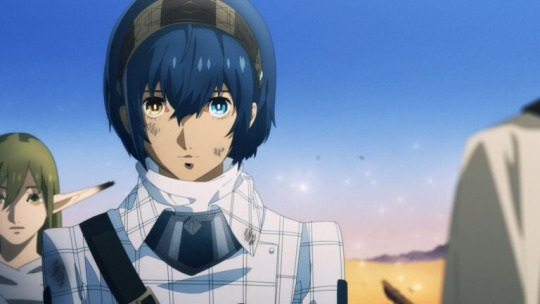
Metaphor: ReFantazio will launch for PlayStation 5, Xbox Series, PlayStation 4, and PC via Steam and Microsoft Store in fall 2024, publisher ATLUS and developer Studio Zero announced.
Get the latest details below.
In the TGA trailer titled, “The Royal Tournament,” ATLUS announced that their highly anticipated fantasy RPG Metaphor: ReFantazio will launch in Fall 2024.
The trailer features new gameplay scenes, an introduction to the story and fantasy setting, and notes members of the team:
Director – Katsura Hashino (Shin Megami Tensei III: Nocturne, Persona 3, Persona 4, Persona 5)
Character Designer – Shigenori Soejima (Persona 3, Persona 4, Persona 5)
Composer – Shoji Meguro (Shin Megami Tensei III: Nocturne, Persona 3, Persona 4, Persona 5)
Concept Artist – Koda Kazuma (Notable Work: NieR:Automata)
Mechanical Designer – Ikuto Yamashita (Notable Work: Neon Genesis Evangelion)
Additionally, ATLUS will host a special YouTube live broadcast in Japan (Japanese language only) for the game on December 11 at 8:30pm JST / 3:30am PST, that will feature guests from the Japanese VA cast including Natsuki Hanae as Protagonist, Sumire Morohoshi as Gallica, Kensho Ono as Strohl, and Saori Hayami as Hulkenberg.
Story
Our story takes place in The United Kingdom of Euchronia, where the assassination of the king brings chaos and unrest to the land.
Then, one fateful day, a magic known only to the king called the Royal Magic is invoked, and the world becomes embroiled in a royal tournament for the throne.
In the midst of this, the protagonist, together with his partner, the fairy Galica, must find a way to break the curse that has been placed on the prince that the kingdom believes to be dead. To do so, they depart on a journey across the vast land.
They will discover that in order to achieve their goal, they must participate in the tournament for the throne, and this great task shall require them to ally with many friends and followers of the various tribes inhabiting the world.
Protagonist
Together with the fairy, Galica, he embarks on a journey to lift the deadly curse placed on his childhood friend, the prince of Euchronia.
He is a boy of the elda tribe, branded as a “”tainted”” people by the state religion who believe they have inherited dangerous and heretical magic. Being so rare among the populous, they are detested and discriminated against throughout the kingdom.”
Gallica
Not only a traveling companion, Gallica is the guide who helps the protagonist carry out his mission to save the prince. Although she is too small to participate in battles, her knowledge of magic and ability to sense magla is superior to the protagonist due to her fairy nature. She doesn’t mince words, but she is a reassuring ally on his journey.
Strohl
He is a young man of the clemar tribe who meets the protagonist in the recruitment centre for the State Army. A smart young man with a strong sense of justice, he hails from a noble family. And yet, it seems his circumstances are complicated, as it is rare for a noble to enlist in the army alongside commoners.
Hulkenberg
A knight of the roussainte tribe and former member of the royal family’s Kingsguard who served by the prince’s side. Despite her young age, she excelled in the use of various weaponry, and was assigned to the personal guard of the prince. But when the prince was attacked, she failed to protect him and set out to wander, carrying the stigma of this failure in her heart.
Heismay
A former knight of the eugief tribe. He has acute perception compared to most others, due in part to the eugief trait of being sensitive to sound.
With an appearance that differs greatly from other tribes, it’s not uncommon for eugiefs to be discriminated against—and it seems Heismay is no exception, his past his own burden to bear.
New Concept Art
Journey through a vast and magnificent fantasy world. Explore the game alongside an intuitive and beautiful UI that elevates the experience. (Get an exciting sneak peek of the look of Metaphor: ReFantazio with new concept art pieces).
Watch the latest trailer below.
The Royal Tournament Trailer
English
youtube
Japanese
youtube
12 notes
·
View notes
Text
Katsura Hashino, I have beef with you but will I still check out ReFantazio? Unfortunately, yes
5 notes
·
View notes
Text
Here's an interview for Persona 3!
And a translated version of some of that same interview!
And unrelated to that interview, here's a talk Hashino and Soejima did about making P3!
https://s.famitsu.com/game/news/2006/07/30/103,1154254841,57787,0,0.html
If it doesn't work, use the Wayback Machine.
#persona 3#p3#for the original p3#found these ages ago but might as well post the links to websites i have
2 notes
·
View notes
Text
i really wish that before i wrote my whole p5r analysis, i had read that "the theme of royal is there is no one true path to justice" quote. i wrote it so pure of heart. full of trust. maybe i should just change some of the phrasing and add a bit on the end like ""ohhh but what about what the writers said what about the framing" The Writers Are Wrong"
like at face value that weakens my point but the quote is still out there i'm just bringing up the counter argument myself so i can say "okay the writers said this and they believe third sem is a genuine moral dilemma but are you actually going to look at me and tell me what maruki did to sumi wasn't abhorrent. the reason the game doesn't say any of this shit and instead spends the time going to great lengths to tell you about how sad maruki is and how 'he's really a good guy he just wants the best for you :o(' is because katsura hashino is a fucking clown who doesn't understand his own games"
p5r is so good despite itself. p5r has such good character writing trapped in bad story writing. akechi sumire and maruki's characters are so so so good but the story the game wants to tell with them just isn't. goro akechi right on all topics forever also i need to draw more sumis.
#persona 5 royal#p5r spoilers#persona 5 royal spoilers#p5r#i could fix her (talking about p5r)#you don't even have to do much!!! just move the camera over a little and add back in some of the cut content#you made a good game stop telling people it's actually bad. pleagse.#ok i am going to be normal now. unless anyone wants me to talk about p5r more#i would loooove to talk about sumi's and akechi's social links
16 notes
·
View notes
Text
the boss battles are even fun in hsr.... also reminds me a lot of persona 5 set pieces. katsura hashino you will always be famous
8 notes
·
View notes